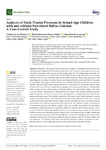Analysis of Static Plantar Pressures in School-Age Children with and without Functional Hallux Limitus: A Case-Control Study

Use este enlace para citar
http://hdl.handle.net/2183/33375Coleccións
- GI-UDISAP - Artigos [192]
Metadatos
Mostrar o rexistro completo do ítemTítulo
Analysis of Static Plantar Pressures in School-Age Children with and without Functional Hallux Limitus: A Case-Control StudyAutor(es)
Data
2023-05Cita bibliográfica
Cuevas-Martínez, C.; Becerro-de-Bengoa-Vallejo, R.; Losa-Iglesias, M.E.; Casado-Hernández, I.; Turné-Cárceles, O.; Pérez-Palma, L.; Martiniano, J.; Gómez-Salgado, J.; López-López, D. Analysis of Static Plantar Pressures in School-Age Children with and without Functional Hallux Limitus: A Case-Control Study. Bioengineering 2023, 10, 628. https://doi.org/ 10.3390/bioengineering10060628
Resumo
[Abstract] Abstract: Background: The presence of hallux limitus in adulthood is frequently encountered in clinical
practice, generating other biomechanical, structural, and functional compensations in dynamics
secondary to blockage of the main pivot in the sagittal plane, the first metatarsophalangeal joint. In
addition, the presence of functional hallux limitus (FHL) in school-age children is also increasing.
Currently, there is a lack of scientific literature about this condition in the pediatric population, and
early diagnosis is necessary to reduce future biomechanical disorders and avoid the development
of foot arthritis. The purpose of this research was to identify static plantar pressures in school-age
children with and without hallux limitus. Methods: A total sample of 106 children aged between
six and twelve years old was divided into two groups: the case group (53 subjects with functional
hallux limitus) and the control group (53 subjects without functional hallux limitus). Data were
acquired with the participants in a standing barefoot position on the pressure platform, and the
hallux limitus functional test was performed in a sitting position to classify the individuals into the
determined study group. The variables analyzed in the research were: plantar pressure, bilateral
forefoot and rearfoot surface area, bilateral forefoot and rearfoot ground reaction forces, bilateral
forefoot and rearfoot distribution of body weight, total left and right surface area, maximum pressure
of the left foot and right foot, medium pressure of the left foot and right foot, ground reaction forces
of the left foot and right foot, and the weight of each foot. Results: Age was the only descriptive
quantitative variable that showed a significant difference between the two study groups, with a
p-value of 0.031. No statistically significant differences were found between groups in the bilateral
forefoot and rearfoot surface area, ground reaction forces, distribution of body weight, or maximum
and medium plantar pressure in the left and right foot. Conclusions: Changes in the location of the maximum pressure were observed, particularly in older participants with FHL, but these results were not significant. The findings of this study did not show significant differences between the static plantar pressures of school-age individuals with and without functional hallux limitus.
Palabras chave
Static
Estática
Plantar pressure
Presión plantar
Foot pressure
Presión en el pie
Children
Niños
Hallux limitus
Estática
Plantar pressure
Presión plantar
Foot pressure
Presión en el pie
Children
Niños
Hallux limitus
Versión do editor
Dereitos
Atribución 3.0 España






